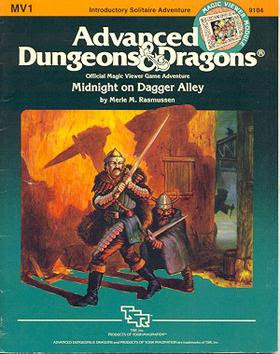Retrospective: Midnight on Dagger Alley
 In my scheme of the broad history of Dungeons & Dragons, the year 1984 falls either at the start of the Silver Age of the game or toward the end of the transitional period of the Electrum Age. Regardless of where one places it – or indeed if one even accepts the idea of neatly defined historical "ages" – I think it's indisputable that 1984 marks the year when TSR fully committed itself to taking D&D in new directions. This was the year that Dragonlance series launched, the first adventure modules based on other media properties appeared, the Companion Rules were published – and when TSR expanded the experimentation with solo play begun in the previous year.
In my scheme of the broad history of Dungeons & Dragons, the year 1984 falls either at the start of the Silver Age of the game or toward the end of the transitional period of the Electrum Age. Regardless of where one places it – or indeed if one even accepts the idea of neatly defined historical "ages" – I think it's indisputable that 1984 marks the year when TSR fully committed itself to taking D&D in new directions. This was the year that Dragonlance series launched, the first adventure modules based on other media properties appeared, the Companion Rules were published – and when TSR expanded the experimentation with solo play begun in the previous year.During 1984, TSR published no fewer than four solo adventures, the majority of which were designed for use with the Basic and Expert rules sets (no surprise, given how well they were apparently selling at the time). The only one written with AD&D in mind was Midnight on Dagger Alley by Merle M. Rasmussen, best known as the creator of Top Secret. The module is the first solitaire "magic viewer modules," so called because it makes use of a strip of transparent red film to read text and maps that have been printed in such a way as to be otherwise illegible. It's a clever solution to the problem posed by the invisible ink modules released in 1983: ensuring re-playability. Unlike its predecessors, Midnight on Dagger Alley is presented in such a way that it can be used multiple times. However, it would seem that the module was not all that well received among potential customers, as TSR never produced another adventure like it.
A player of the module chooses one of three pre-generated characters, a lawful neutral human monk, a neutral evil half-elf assassin, or a neutral elf thief. Two things immediately stand out about these characters, beyond the fact that they are all level six. The first is that they all possess thieving abilities to some degree. The second is that none of them have a good alignment (and indeed one of them is explicitly evil). This surprises me in retrospect, since the Silver Age is when TSR began to worry about "angry mothers from heck" and how they viewed the content of Dungeons & Dragons. In this context, Midnight on Dagger Alley a little like a throwback to the pulp fantasy roots of the game.
Each character has his own unique task in the city of Goldstar, where the module is set. The text of the module is divided into four parts, each associated with a different part of the city: dungeon, street, upper level, and roof. Each part contains numbered entries whose text is (mostly) illegible due to be hidden underneath printed patterns that only disappear with the use of the magic viewer. There are also maps of the relevant parts of the city that function in the same way. Much like a Choose Your Own Adventure book, the player of Midnight on Dagger Alley movies between entries by making choices that direct him to other entries. And much like the Fighting Fantasy series – and, of course, D&D itself – there are dice to be rolled, for combat among others, that also play a roll in advancing through the entries.
I owned a copy of this as a teenager and had a surprisingly good time with it. My main complaint about it was that it was quite short – only eight pages in length – and the three scenarios associated with the pre-generated characters all took place within a very limited space of the city. That was clearly done for logistical reasons and, having tried my hand at writing a solitaire adventure or two over the years, I am sympathetic to Rasmussen's plight. Still, there are only about 120 entries in total, most of them quite short, so the range of action is indeed quite limited and that's a genuine drawback. On the other hand, I appreciate what Rasmussen and TSR were attempting to achieve with Midnight on Dagger Alley, even if their reach exceeded their grasp.
James Maliszewski's Blog
- James Maliszewski's profile
- 3 followers



